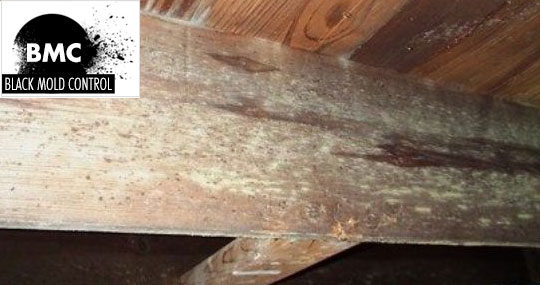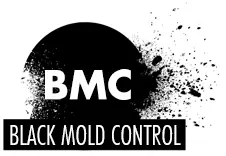Have you ever entered your crawl space and become overwhelmed by the amount of black mold lining the walls? What exactly can it do to your health, and is there a way to get rid of it for good? Here’s everything you need to know before tackling the mold in your crawl space.

Table of contents
What causes crawl space mold?
Moisture and ventilation cause the growth of spores in a crawl space. Many spaces have vents to encourage ventilation. When these vents are opened during the warmer months, the generally cool air from the space mixes with the outside humidity. This creates condensation. The wooden floors and joists of your house provide a food source for the mold, which will continue to spread as the cool and warm air collide.
How much mold in crawl space is acceptable?
There is no acceptable amount in a crawl space! Growth can not only damage the joists holding the house in place; it can also be detrimental to your health. Even the smallest growth should be eliminated before it takes over the space.
Types of mold
There are several types of spores that grow in crawl spaces, including but not limited to white, black, and yellow.
White
Several types of spores fall into this category. Penicillum, cladosporium, and aspergillus are the most common. Penicillum grows in moist climates and, when inhaled, can cause respiratory dysfunction. Cladosporium grows in any climate and causes asthma, skin lesions, and sinusitis. Aspergillus actually presents in a variety of colors and causes respiratory illnesses such as asthma. It also gives off aflatoxins; these can be carcinogenic. These type of spores are likely found on wooden joists and in soil.
Black
Stachyboytrys grows best in damp humidity. It feeds off of cellulose based materials like wood, paper, or cardboard. When inhaled, stachyboytrys makes it hard to breathe and can even cause depression and fatigue. Long term exposure leads to headaches, nosebleeds, and neurological problems.
However, its name is misleading; stachyboytrys is actually gray or green. No matter the color, it produces mycotoxins known to trigger severe allergic reactions in those who come in contact with it.
Yellow
Yellow growths include mucor, serpula lacrymans, geomyces pannorum, and epicoccum nigrum. Mucor is a fast growing strain that can quickly overtake a home. Exposure may cause mucormycosis, a potentially killer condition in which the blood vessels are compromised by mold follicles. Serpula lacrymans feeds on wooden joists. Geomyces pannorum grows exclusively in cold climates, feeding on cellulose materials like paper. Epicoccum nigrum also feeds on wood and paper, but also spreads to drywall.
Signs of crawl space mold problems
Wondering if you’re having this problem? Pay attention to any musty smells or the feeling of excessive moisture in your house. Your utility bills may skyrocket thanks to a water or air conditioning leak; this leak provides the moisture for fungal growth. Pay attention to any infestations of pests, as their pathway into your home provides the ventilation needed for growth. Additionally, monitor yourself for symptoms of allergies or trouble breathing.
If there is black mold below the house, it will not be long before it is in your house. This is because of the stack effect. The stack effect indicates that humidity rises. Since that moist climate is perfect for the growth of mold, the rising humidity will bring black spores with it.
Can black mold in crawl space make you sick?
Yes, stachyboytrys can make you sick. Minor symptoms mirror allergies and include nosebleeds, a stuffy nose, itchy eyes, and coughing. Longer exposure yields headaches, repetitive chest colds, sinusitis, fatigue, and a seemingly unending cough. Prolonged exposure can cause memory loss, nerve issues, muscle cramping, weight gain, anxiety, and trouble concentrating.

Mold on joists in crawl space
Just as stachyboytrys exposure can eat away at your health, it can eat away at the wooden joists of your house. The joists not only provide a home for the substance; they also act as a nutrient. As the stachyboytrys feeds on the cellulose material of the wood, it grows, emitting a strong, musty smell as it does so.
DIY removal and cleanup
If it has just started appearing, you can try DIY remediation methods to kill it and prevent further growth. Apply a treatment of the killing agent to the surface, allow to soak, and then wipe away. Once the surfaces are dry, prevent the area from becoming musty by encapsulating it. Seal entrances and vents after lining the entire area with a thick barrier that prevents any moisture from seeping through. For extra protection, a dehumidifier can be placed inside. While working, make sure to use gloves, eye protection, and a respirator to filter the air you are breathing.
As far as cost, a DIY removal can be done for under $100. However, if the problem requires the use of a professional service, the cost can be exponentially more expensive depending on the amount of growth and damage done.
Best mold killer for crawl spaces
Bleach, tea tree oil, vinegar, or sodium bicarbonate all act as removal tools that can be easily purchased at a department store. If you are seeking a specialized product, the Allertech Remediation Kit has everything you need–an removal agent, goggles, gloves, and a respirator. This kit can be found for the cost of $85 on Amazon.
Does a mold fogger work?
Foggers are successful in the removal of existing black mold. However, they do not penetrate deeply enough to remove individual spores. This gives the fungus the upper hand, ensuring it will grow back despite the use of the fogger.
Hiring a mold remediation professional
Knowing when to draw the line and call a remediation professional is key. A strong, musty smell or the appearance of allergy symptoms in you or your family are sure signs that a professional is needed. The failure of over an counter treatment is another sign that the problem is out of your hand, as well as an inability to curb the humidity coming into the area.
Crawl space mold remediation cost
Before turning the job over to a professional spore killer, understand that you may incur a hefty cost. Treatment of heavily infested areas run anywhere between $500 and $30,000. The cost depends on the extent of damage and the amount of materials needed to fix it.
The growth of black mold spores in a crawl space is a serious problem. It does not matter if they are black, white, or yellow–they should be removed at the first sign of growth. Call us today to schedule your free quote!
